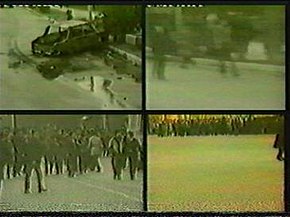
Back مذبحة سومغيت Arabic Sumqayıt hadisələri (1988) AZ Сумгаитски погром Bulgarian Sumgaitský pogrom Czech Pogrom in Sumgait German Pogromo de Sumgait EO Pogromo de Sumgait Spanish کشتار سومقاییت FA Sumgaitin verilöyly Finnish Pogrom de Soumgaït French
| Sumgait pogrom | |
|---|---|
| Part of the Nagorno-Karabakh conflict, First Nagorno-Karabakh War and the dissolution of the Soviet Union | |
 Images from a videotape show burnt automobiles and throngs of rioters on the streets of Sumgait. | |
| Location | Sumgait, Azerbaijan, Soviet Union |
| Date | February 27 – March 1, 1988 |
| Target | Local Armenian population |
Attack type | Murder, rape, riot[1] |
| Deaths | 32 (official Soviet data) 200+ (Armenian sources)[2] |
| Injured | Unknown |
The Sumgait pogrom[note 1] was a pogrom that targeted the Armenian population of the lakeside town of Sumgait in the Azerbaijan Soviet Socialist Republic in late February 1988. The pogrom took place during the early stages of the Karabakh movement. On February 27, 1988, mobs of ethnic Azerbaijanis formed into groups and attacked and killed Armenians on the streets and in their apartments; widespread looting occurred, and a general lack of concern from police officers allowed the violence to continue for three days.[3]
On February 28, a small contingent of Ministry of Internal Affairs (MVD) troops entered the city and unsuccessfully attempted to quell the rioting. More professional military units entered with tanks and armored personnel vehicles one day later. Government forces imposed a state of martial law and curfew and brought the crisis to an end. The official death toll released by the Prosecutor General of the USSR was 32 Armenians, although other estimates reach up into the hundreds of victims.[4]
The violence in Sumgait was unexpected and was widely covered in the Western media. It was greeted with general surprise in Armenia and the rest of the Soviet Union since ethnic conflicts in the country had been largely suppressed by the Soviet government, which had promoted policies such as fraternity of peoples, socialist patriotism, and proletarian internationalism to avert such conflicts. The policies of glasnost and perestroika, introduced by Soviet leader Mikhail Gorbachev in 1987, had decreased suppression of the population, which had the unintended consequence of allowing ethnic conflicts and ethnic nationalism to increase in the Soviet Union. The massacre, together with the Nagorno-Karabakh conflict, presented a major challenge to Gorbachev, and he was later criticized for his slow response to the crisis.
Because of the scale of atrocities against the Armenians as an ethnic group the pogrom was immediately linked to the Armenian genocide of 1915 in the Armenian national consciousness.[5][6] Russian political writer Roy Medvedev and USSR Journalists' Union described the events as genocide of the Armenian population.[7][8] The Sumgait pogrom is commemorated every year on February 28 in Armenia, Nagorno-Karabakh (before the flight of its Armenian population), and among the Armenian diaspora.[9]
- ^ De Waal, Thomas (2010). The Caucasus: An Introduction. New York: Oxford University Press. p. 111. ISBN 978-0-19539977-6.
- ^ Vaserman, Arie; Ginat, Ram (1994). "National, territorial or religious conflict? The case of Nagorno-Karabakh". Studies in Conflict & Terrorism. 17 (4): 348. doi:10.1080/10576109408435961.
These events contributed to the anti-Armenian riots of February 28–29 in Sumgait near Baku. According to official data, 32 Armenians were killed during the riots, but various Armenian sources claimed that more than 200 people were killed.
- ^ Rodina. No. 4, 1994, pp. 82–90.
- ^ Vaserman, Arie; Ginat, Ram (1994). "National, territorial or religious conflict? The case of Nagorno-Karabakh". Studies in Conflict & Terrorism. 17 (4): 348. doi:10.1080/10576109408435961.
These events contributed to the anti-Armenian riots of February 28–29 in Sumgait near Baku. According to official data, 32 Armenians were killed during the riots, but various Armenian sources claimed that more than 200 people were killed.
- ^ Hovhannisyan, Mari (2010). "The Collective Memory of the Armenian Genocide". Budapest: Central European University. p. 21. Archived from the original on November 29, 2014.
The posters carried by the Armenians on April 24, 1988 were verifications of the fact that Armenians saw the Sumgait massacres as the continuation of the genocide.
- ^ Pheiffer, Evan (June 1, 2016). "A Place to Live For". Jacobin. Archived from the original on September 19, 2016.
Complicating matters, Armenians seem incapable of separating the 1988 pogroms from the 1915 Ottoman atrocities — mention of one immediately triggers talk of the other.
- ^ Glasnost: Vol. 2, Issue 1, Center for Democracy (New York, NY) – 1990, p. 62, cit. 'The massacre of Armenians in Sumgait, the heinous murders in Tbilisi—these killings are examples of genocide directed by the Soviet regime against its own people.', an announcement by USSR Journalists' Union
- ^ Medvedev, Roy Aleksandrovich; Giulietto, Chiesa (1989). Time of change : an insider's view of Russia's transformation. Translated by Moore, Michael. New York: Pantheon Books. p. 209. ISBN 0-394-58151-2. OCLC 20593737.
- ^ "Communities Worldwide Mark Sumgait Anniversary Along with Government Officials". Asbarez. March 1, 2011. Archived from the original on November 29, 2014.
Cite error: There are <ref group=note> tags on this page, but the references will not show without a {{reflist|group=note}} template (see the help page).